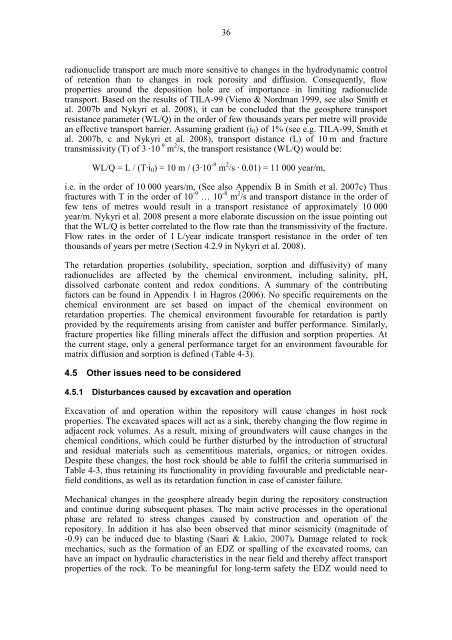RSC-Programme - Interim Report. Approach and Basis for - Posiva
RSC-Programme - Interim Report. Approach and Basis for - Posiva
RSC-Programme - Interim Report. Approach and Basis for - Posiva
You also want an ePaper? Increase the reach of your titles
YUMPU automatically turns print PDFs into web optimized ePapers that Google loves.
36radionuclide transport are much more sensitive to changes in the hydrodynamic controlof retention than to changes in rock porosity <strong>and</strong> diffusion. Consequently, flowproperties around the deposition hole are of importance in limiting radionuclidetransport. Based on the results of TILA-99 (Vieno & Nordman 1999, see also Smith etal. 2007b <strong>and</strong> Nykyri et al. 2008), it can be concluded that the geosphere transportresistance parameter (WL/Q) in the order of few thous<strong>and</strong>s years per metre will providean effective transport barrier. Assuming gradient (i 0 ) of 1% (see e.g. TILA-99, Smith etal. 2007b, c <strong>and</strong> Nykyri et al. 2008), transport distance (L) of 10 m <strong>and</strong> fracturetransmissivity (T) of 3 ∙10 9 m 2 /s, the transport resistance (WL/Q) would be:WL/Q = L / (T∙i 0 ) = 10 m / (3∙10 -9 m 2 /s ∙ 0.01) = 11 000 year/m,i.e. in the order of 10 000 years/m, (See also Appendix B in Smith et al. 2007c) Thusfractures with T in the order of 10 -9 … 10 -8 m 2 /s <strong>and</strong> transport distance in the order offew tens of metres would result in a transport resistance of approximately 10 000year/m. Nykyri et al. 2008 present a more elaborate discussion on the issue pointing outthat the WL/Q is better correlated to the flow rate than the transmissivity of the fracture.Flow rates in the order of 1 L/year indicate transport resistance in the order of tenthous<strong>and</strong>s of years per metre (Section 4.2.9 in Nykyri et al. 2008).The retardation properties (solubility, speciation, sorption <strong>and</strong> diffusivity) of manyradionuclides are affected by the chemical environment, including salinity, pH,dissolved carbonate content <strong>and</strong> redox conditions. A summary of the contributingfactors can be found in Appendix 1 in Hagros (2006). No specific requirements on thechemical environment are set based on impact of the chemical environment onretardation properties. The chemical environment favourable <strong>for</strong> retardation is partlyprovided by the requirements arising from canister <strong>and</strong> buffer per<strong>for</strong>mance. Similarly,fracture properties like filling minerals affect the diffusion <strong>and</strong> sorption properties. Atthe current stage, only a general per<strong>for</strong>mance target <strong>for</strong> an environment favourable <strong>for</strong>matrix diffusion <strong>and</strong> sorption is defined (Table 4-3).4.5 Other issues need to be considered4.5.1 Disturbances caused by excavation <strong>and</strong> operationExcavation of <strong>and</strong> operation within the repository will cause changes in host rockproperties. The excavated spaces will act as a sink, thereby changing the flow regime inadjacent rock volumes. As a result, mixing of groundwaters will cause changes in thechemical conditions, which could be further disturbed by the introduction of structural<strong>and</strong> residual materials such as cementitious materials, organics, or nitrogen oxides.Despite these changes, the host rock should be able to fulfil the criteria summarised inTable 4-3, thus retaining its functionality in providing favourable <strong>and</strong> predictable nearfieldconditions, as well as its retardation function in case of canister failure.Mechanical changes in the geosphere already begin during the repository construction<strong>and</strong> continue during subsequent phases. The main active processes in the operationalphase are related to stress changes caused by construction <strong>and</strong> operation of therepository. In addition it has also been observed that minor seismicity (magnitude of-0.9) can be induced due to blasting ( Damage related to rockmechanics, such as the <strong>for</strong>mation of an EDZ or spalling of the excavated rooms, canhave an impact on hydraulic characteristics in the near field <strong>and</strong> thereby affect transportproperties of the rock. To be meaningful <strong>for</strong> long-term safety the EDZ would need to
















